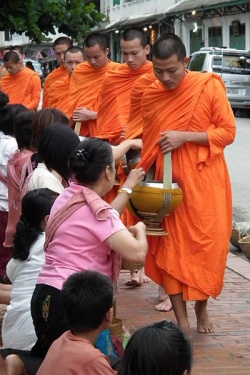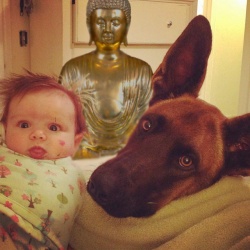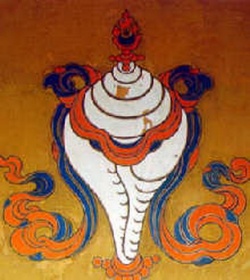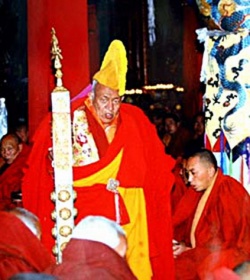Difference between revisions of "Rebirth (Buddhism)"
(Created page with " Rebirth in Buddhism is the doctrine that the evolving consciousness (Pali: samvattanika-viññana) or stream of consciousness (Pali: viñ...") |
|||
| (2 intermediate revisions by the same user not shown) | |||
| Line 1: | Line 1: | ||
| − | + | <nomobile>{{DisplayImages|2384|1968|2575|2555|3546|3349|1969}}</nomobile> | |
| Line 11: | Line 11: | ||
The [[consciousness]] in the new [[person]] is neither [[identical]] nor entirely different from that in the deceased but the two [[form]] a causal {{Wiki|continuum}} or {{Wiki|stream}}. | The [[consciousness]] in the new [[person]] is neither [[identical]] nor entirely different from that in the deceased but the two [[form]] a causal {{Wiki|continuum}} or {{Wiki|stream}}. | ||
| − | In [[traditional]] [[Buddhist cosmology]] these [[lives]] can be in any of a large number of states of being including the [[human]], any kind of [[animal]] and several types of [[supernatural]] being. | + | In [[traditional]] [[Buddhist cosmology]] these [[lives]] can be in any of a large number of states of being [[including]] the [[human]], any kind of [[animal]] and several types of [[supernatural]] being. |
[[Rebirth]] is [[conditioned]] by the [[karmas]] ([[actions]] of [[body, speech and mind]]) of previous [[lives]]; good [[karmas]] will yield a [[happier]] [[rebirth]], bad [[karmas]] will produce one which is more [[unhappy]]. | [[Rebirth]] is [[conditioned]] by the [[karmas]] ([[actions]] of [[body, speech and mind]]) of previous [[lives]]; good [[karmas]] will yield a [[happier]] [[rebirth]], bad [[karmas]] will produce one which is more [[unhappy]]. | ||
| Line 19: | Line 19: | ||
| − | [[Buddhist | + | ==[[Buddhist terminology and doctrine]]== |
| − | There is no [[word]] corresponding exactly to the English terms "[[rebirth]]", "[[metempsychosis]]", "[[transmigration]]" or "[[reincarnation]]" in the [[traditional]] [[Buddhist]] [[languages]] of [[Pāli]] and [[Sanskrit]]: | + | There is no [[word]] [[corresponding]] exactly to the English terms "[[rebirth]]", "[[metempsychosis]]", "[[transmigration]]" or "[[reincarnation]]" in the [[traditional]] [[Buddhist]] [[languages]] of [[Pāli]] and [[Sanskrit]]: |
the entire process of change from one [[life]] to the next is called "becoming again"(Sanskrit: [[punarbhava]], [[Pali]]: | the entire process of change from one [[life]] to the next is called "becoming again"(Sanskrit: [[punarbhava]], [[Pali]]: | ||
| − | [[punabbhava]]), or more briefly "becoming" (Pali/Sanskrit: [[bhava]]), while the [[state]] one is born into, the {{Wiki|individual}} process of being born or coming into the [[world]] in any way, is referred to simply as "[[birth]]" (Pali/Sanskrit: [[jāti]]). | + | [[punabbhava]]), or more briefly "becoming" ([[Pali]]/[[Sanskrit]]: [[bhava]]), while the [[state]] one is born into, the {{Wiki|individual}} process of being born or coming into the [[world]] in any way, is referred to simply as "[[birth]]" ([[Pali]]/[[Sanskrit]]: [[jāti]]). |
The entire [[universal]] process of [[beings]] being [[reborn]] again and again is called "wandering about" (Pali/Sanskrit: [[saṃsāra]]). | The entire [[universal]] process of [[beings]] being [[reborn]] again and again is called "wandering about" (Pali/Sanskrit: [[saṃsāra]]). | ||
| Line 34: | Line 34: | ||
Within one [[life]] and across multiple [[lives]], the [[empirical]], changing [[self]] not only objectively affects its surrounding [[external world]], but also generates ([[consciously]] and {{Wiki|unconsciously}}) its [[own]] [[subjective]] image of this [[world]], which it then [[lives]] in as '[[reality]]'. | Within one [[life]] and across multiple [[lives]], the [[empirical]], changing [[self]] not only objectively affects its surrounding [[external world]], but also generates ([[consciously]] and {{Wiki|unconsciously}}) its [[own]] [[subjective]] image of this [[world]], which it then [[lives]] in as '[[reality]]'. | ||
| − | It [[lives]] in a [[world]] of its [[own]] making in various ways. It "tunes in" to a particular level of [[consciousness]] (by [[meditation]] or the [[rebirth]] it attains through its [[karma]]) which has a particular range of [[objects]] - a [[world]] - available to it. | + | It [[lives]] in a [[world]] of its [[own]] making in various ways. |
| + | |||
| + | It "tunes in" to a particular level of [[consciousness]] (by [[meditation]] or the [[rebirth]] it attains through its [[karma]]) which has a particular range of [[objects]] - a [[world]] - available to it. | ||
It furthermore selectively notices from among such [[objects]], and then {{Wiki|processes}} what has been [[sensed]] to [[form]] a distorted interpretive model of [[reality]]: a model in which the 'I am' [[conceit]] is a crucial reference point. | It furthermore selectively notices from among such [[objects]], and then {{Wiki|processes}} what has been [[sensed]] to [[form]] a distorted interpretive model of [[reality]]: a model in which the 'I am' [[conceit]] is a crucial reference point. | ||
When [[nirvana]] is [[experienced]], though, all such models are transcended: the [[world]] stops 'in this fathom-long carcase'. | When [[nirvana]] is [[experienced]], though, all such models are transcended: the [[world]] stops 'in this fathom-long carcase'. | ||
| − | |||
Historical context | Historical context | ||
| − | |||
| Line 62: | Line 62: | ||
The [[Buddha's]] {{Wiki|concept}} was {{Wiki|distinct}}, consistent with the common notion of a sequence of [[lives]] over a very long time but constrained by two core [[Wikipedia:concept|concepts]]: | The [[Buddha's]] {{Wiki|concept}} was {{Wiki|distinct}}, consistent with the common notion of a sequence of [[lives]] over a very long time but constrained by two core [[Wikipedia:concept|concepts]]: | ||
| − | that there is no irreducible [[self]] tying these [[lives]] together ([[anattā]]) and that all [[compounded]] things are [[subject]] to dissolution, including all the components of the [[human]] [[person]] and [[personality]] ([[anicca]]). | + | that there is no irreducible [[self]] tying these [[lives]] together ([[anattā]]) and that all [[compounded]] things are [[subject]] to dissolution, [[including]] all the components of the [[human]] [[person]] and [[personality]] ([[anicca]]). |
The story of the [[Buddha's life]] presented in the early texts does not allude to the [[idea]] of [[rebirth]] prior to his [[enlightenment]], leading some to suggest that he discovered it for himself. | The story of the [[Buddha's life]] presented in the early texts does not allude to the [[idea]] of [[rebirth]] prior to his [[enlightenment]], leading some to suggest that he discovered it for himself. | ||
| Line 69: | Line 69: | ||
| − | [[Ideas | + | ==[[Ideas of rebirth]]== |
| − | There are many references to [[rebirth]] in the early [[Buddhist scriptures]] | + | There are many references to [[rebirth]] in the early [[Buddhist scriptures]]. |
| + | |||
| + | These are some of the more important; | ||
| + | |||
| + | |||
| + | <poem> | ||
| + | [[Mahakammavibhanga Sutta]] ([[Majjhima Nikaya]] 136); | ||
| + | [[Upali Sutta]] ([[Majjhima Nikaya]] 56); | ||
| + | [[Kukkuravatika Sutta]] ([[Majjhima Nikaya]] 57); | ||
| + | [[Moliyasivaka Sutta]] ([[Samyutta Nikaya]] 36.21); | ||
| + | [[Sankha Sutta]] ([[Samyutta Nikaya]] 42.8). | ||
| + | </poem> | ||
| Line 103: | Line 114: | ||
[[Theravada Buddhism]] generally denies there is an [[intermediate state]], though some early [[Buddhist texts]] seem to support it. | [[Theravada Buddhism]] generally denies there is an [[intermediate state]], though some early [[Buddhist texts]] seem to support it. | ||
| − | There are zero teachings about this [[state]] found in the Agamas/Nikayas of the [[early schools]], only vague references to said [[state]] that are open to [[interpretation]]. | + | There are zero teachings about this [[state]] found in the [[Agamas]]/[[Nikayas]] of the [[early schools]], only vague references to said [[state]] that are open to [[interpretation]]. |
Among the thousands of [[suttas]] there is not a single one that gives any instruction on how one could influence one's [[rebirth]] in some kind of in between stage, just a handful of passages that could imply that there is some kind of {{Wiki|interval}} between [[death]] and [[birth]]. | Among the thousands of [[suttas]] there is not a single one that gives any instruction on how one could influence one's [[rebirth]] in some kind of in between stage, just a handful of passages that could imply that there is some kind of {{Wiki|interval}} between [[death]] and [[birth]]. | ||
| Line 109: | Line 120: | ||
There are some passages that imply one could reach Nibbana/Nirvana in this between [[state]] but as mentioned above there is zero instruction on how to do so. | There are some passages that imply one could reach Nibbana/Nirvana in this between [[state]] but as mentioned above there is zero instruction on how to do so. | ||
| − | Therefore it's just as likely that the practices allowing one to reach Nibbana/Nirvana in this [[state]] are totally unrelated to the [[state]] itself and instead would simply be the end result of the standard practices laid out in the Agamas/Nikayas (as opposed to being the result of some kind of practice similar to the [[Tibetan]] [[Bardo]] practice). | + | Therefore it's just as likely that the practices allowing one to reach [[Nibbana]]/[[Nirvana]] in this [[state]] are totally unrelated to the [[state]] itself and instead would simply be the end result of the standard practices laid out in the [[Agamas]]/[[Nikayas]] (as opposed to being the result of some kind of practice similar to the [[Tibetan]] [[Bardo]] practice). |
One school that adopted the view of possibly influencing ones [[rebirth]] while in the in between [[state]] was the [[Sarvastivada]], who believed that between [[death]] and [[rebirth]] there is a sort of limbo in which [[beings]] do not yet reap the {{Wiki|consequences}} of their previous [[actions]] but may still influence their [[rebirth]]. | One school that adopted the view of possibly influencing ones [[rebirth]] while in the in between [[state]] was the [[Sarvastivada]], who believed that between [[death]] and [[rebirth]] there is a sort of limbo in which [[beings]] do not yet reap the {{Wiki|consequences}} of their previous [[actions]] but may still influence their [[rebirth]]. | ||
| − | The [[death]] process and this [[intermediate state]] were believed to offer a uniquely [[favourable]] opportunity for [[spiritual awakening]]. There are zero teachings about this [[state]] found in the Agamas/Nikayas of the [[early schools]]. Only vague references to said [[state]]. | + | The [[death]] process and this [[intermediate state]] were believed to offer a uniquely [[favourable]] opportunity for [[spiritual awakening]]. There are zero teachings about this [[state]] found in the [[Agamas]]/[[Nikayas]] of the [[early schools]]. |
| + | |||
| + | Only vague references to said [[state]]. | ||
| + | |||
| + | ==[[Rebirth as cycle of consciousness]]== | ||
| − | |||
| + | Another view of [[rebirth]] describes the [[cycle of death and birth]] in the context of [[consciousness]] rather than the [[birth]] and [[death of the body]]. In this view, remaining impure [[aggregates]], [[skandhas]], reform [[consciousness]]. | ||
| − | |||
| + | [[Buddhist meditation]] [[teachers]] suggest that observation reveals [[consciousness]] as a sequence of [[conscious]] moments rather than a {{Wiki|continuum}} of [[awareness]]. | ||
| − | + | Each [[moment]] is an [[experience]] of an {{Wiki|individual}} [[mind-state]] such as a [[thought]], a [[memory]], a [[feeling]] or a [[perception]]. | |
A [[mind-state]] arises, [[exists]] and, being [[impermanent]], ceases, following which the next [[mind-state]] arises. | A [[mind-state]] arises, [[exists]] and, being [[impermanent]], ceases, following which the next [[mind-state]] arises. | ||
| Line 129: | Line 144: | ||
{{W}} | {{W}} | ||
[[Category:Death & Rebirth]] | [[Category:Death & Rebirth]] | ||
| + | [[Category:Reincarnation]] | ||
Latest revision as of 05:00, 29 September 2020
Rebirth in Buddhism is the doctrine that the evolving consciousness (Pali: samvattanika-viññana) or stream of consciousness (Pali: viññana-sotam, Sanskrit: vijñāna-srotām, vijñāna-santāna, or citta-santāna) upon death (or "the dissolution of the aggregates" (P. khandhas, S. skandhas)), becomes one of the contributing causes for the arising of a new aggregation.
The consciousness in the new person is neither identical nor entirely different from that in the deceased but the two form a causal continuum or stream.
In traditional Buddhist cosmology these lives can be in any of a large number of states of being including the human, any kind of animal and several types of supernatural being.
Rebirth is conditioned by the karmas (actions of body, speech and mind) of previous lives; good karmas will yield a happier rebirth, bad karmas will produce one which is more unhappy.
The basic cause for this is the abiding of consciousness in ignorance (Pali: avijja, Sanskrit: avidya): when ignorance is uprooted, rebirth ceases. One of the analogies used to describe what happens then is that of a ray of light that never lands.
Buddhist terminology and doctrine
There is no word corresponding exactly to the English terms "rebirth", "metempsychosis", "transmigration" or "reincarnation" in the traditional Buddhist languages of Pāli and Sanskrit:
the entire process of change from one life to the next is called "becoming again"(Sanskrit: punarbhava, Pali:
punabbhava), or more briefly "becoming" (Pali/Sanskrit: bhava), while the state one is born into, the individual process of being born or coming into the world in any way, is referred to simply as "birth" (Pali/Sanskrit: jāti).
The entire universal process of beings being reborn again and again is called "wandering about" (Pali/Sanskrit: saṃsāra).
Within one life and across multiple lives, the empirical, changing self not only objectively affects its surrounding external world, but also generates (consciously and unconsciously) its own subjective image of this world, which it then lives in as 'reality'.
It lives in a world of its own making in various ways.
It "tunes in" to a particular level of consciousness (by meditation or the rebirth it attains through its karma) which has a particular range of objects - a world - available to it.
It furthermore selectively notices from among such objects, and then processes what has been sensed to form a distorted interpretive model of reality: a model in which the 'I am' conceit is a crucial reference point.
When nirvana is experienced, though, all such models are transcended: the world stops 'in this fathom-long carcase'.
Historical context
The Buddha lived at a time of great philosophical creativity in India when many conceptions of the nature of life and death were proposed.
Some were materialist, holding that there was no existence and that the self is annihilated upon death.
Others believed in a form of cyclic existence, where a being is born, lives, dies and then is reborn, but in the context of a type of determinism or fatalism in which karma played no role.
Others were "eternalists", postulating an eternally existent self or soul comparable to that in Christianity:
the ātman survives death and reincarnates as another living being, based on its karmic inheritance.
This is the idea that has become dominant (with certain modifications) in modern Hinduism.
The Buddha's concept was distinct, consistent with the common notion of a sequence of lives over a very long time but constrained by two core concepts:
that there is no irreducible self tying these lives together (anattā) and that all compounded things are subject to dissolution, including all the components of the human person and personality (anicca).
The story of the Buddha's life presented in the early texts does not allude to the idea of rebirth prior to his enlightenment, leading some to suggest that he discovered it for himself.
The Buddha's detailed conception of the connections between action (karma), rebirth and causality is set out in the twelve links of dependent origination.
Ideas of rebirth
There are many references to rebirth in the early Buddhist scriptures.
These are some of the more important;
Mahakammavibhanga Sutta (Majjhima Nikaya 136);
Upali Sutta (Majjhima Nikaya 56);
Kukkuravatika Sutta (Majjhima Nikaya 57);
Moliyasivaka Sutta (Samyutta Nikaya 36.21);
Sankha Sutta (Samyutta Nikaya 42.8).
Some English-speaking Buddhists prefer the term "rebirth" or "re-becoming" (Sanskrit: punarbhava; Pali: punabbhava) to "reincarnation" as they take the latter to imply a fixed entity that is reborn.
It is said to be the "evolving consciousness" (Pali: samvattanika viññana, M.1.256) or "stream of consciousness" (Pali: viññana sotam, D.3.105) that reincarnates.
The early Buddhist texts make it clear that there is no permanent consciousness that moves from life to life.
The lack of a fixed self does not mean lack of continuity. In the same way that a flame is transferred from one candle to another, there is a conditioned relationship between one life and the next: they are neither identical nor completely distinct.
While all Buddhist traditions seem to accept some notion of rebirth, there is no unified view about precisely how events unfold after the moment of death.
The medieval Pali scholar Buddhaghosa labeled the consciousness that constitutes the condition for a new birth as described in the early texts "rebirth-linking consciousness" (patisandhi).
Some schools conclude that karma continued to exist and adhere to the person until it had worked out its consequences.
For the Sautrantika school each act "perfumed" the individual and led to the planting of a "seed" that would later germinate as a good or bad karmic result.
Theravada Buddhism generally asserts that rebirth is immediate while the Tibetan schools hold to the notion of a bardo (intermediate state) that can last up to forty-nine days.
This has led to the development of a unique 'science' of death and rebirth, a good deal of which is set down in what is popularly known as The Tibetan Book of the Dead.
Theravada Buddhism generally denies there is an intermediate state, though some early Buddhist texts seem to support it.
There are zero teachings about this state found in the Agamas/Nikayas of the early schools, only vague references to said state that are open to interpretation.
Among the thousands of suttas there is not a single one that gives any instruction on how one could influence one's rebirth in some kind of in between stage, just a handful of passages that could imply that there is some kind of interval between death and birth.
There are some passages that imply one could reach Nibbana/Nirvana in this between state but as mentioned above there is zero instruction on how to do so.
Therefore it's just as likely that the practices allowing one to reach Nibbana/Nirvana in this state are totally unrelated to the state itself and instead would simply be the end result of the standard practices laid out in the Agamas/Nikayas (as opposed to being the result of some kind of practice similar to the Tibetan Bardo practice).
One school that adopted the view of possibly influencing ones rebirth while in the in between state was the Sarvastivada, who believed that between death and rebirth there is a sort of limbo in which beings do not yet reap the consequences of their previous actions but may still influence their rebirth.
The death process and this intermediate state were believed to offer a uniquely favourable opportunity for spiritual awakening. There are zero teachings about this state found in the Agamas/Nikayas of the early schools.
Only vague references to said state.
Rebirth as cycle of consciousness
Another view of rebirth describes the cycle of death and birth in the context of consciousness rather than the birth and death of the body. In this view, remaining impure aggregates, skandhas, reform consciousness.
Buddhist meditation teachers suggest that observation reveals consciousness as a sequence of conscious moments rather than a continuum of awareness.
Each moment is an experience of an individual mind-state such as a thought, a memory, a feeling or a perception.
A mind-state arises, exists and, being impermanent, ceases, following which the next mind-state arises.
Thus the consciousness of a sentient being can be seen as a continuous series of birth and death of these mind-states. Rebirth is the persistence of this process.






